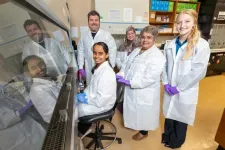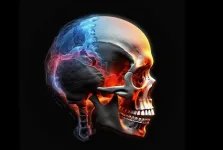(Press-News.org) The Eunice Kennedy Shriver National Institute of Child Health and Human Development awarded $3.1 million to the University of Arkansas to study a spectrum of pediatric mitochondrial disorders caused by mutations in the mitochondria. These disorders often impact different organs requiring energy and can lead to mitochondria-induced multiple organ disorder syndromes, or MIMODS.
Shilpa Iyer, an associate professor of biological sciences, will serve as the principal investigator on the five-year award. Iyer and her team conduct research on mitochondrial diseases and have received grants from Arkansas Bioscience Institute, National Institute of Health and the Department of Defense. Her team has obtained skin cells from mitochondrial patients and are creating disease-specific stem cells to better understand the role of bioenergetics and mitochondrial mutations in vital tissue types — such as the heart, nerve, muscle, and kidney — that are affected by mitochondrial diseases.
Mitochondria, the tiny organelles inside cells, play a critical role in producing metabolic energy by oxidizing carbohydrates, protein and fats. In the presence of oxygen, this organelle combines with glucose and fats to create ATP, or adenosine triphosphate, which is the energy fuel for sustaining life. Many devastating diseases can arise from damage to mitochondria and could contribute to MIMODS in children and adults alike.
The NIH award will be used to explore how damage to the mitochondria alters the shape of the mitochondria and adversely impacts bioenergetic function, which in turn can affect the proper functioning of the organs, leading to disease severity and organ failure. The award will test the hypothesis that the causative role of specific metabolites altered by mutations in the mitochondrial genome lead to organ failure in pediatric mitochondrial disorders.
“Starting with skin cells from children with mitochondrial disorders, our team is involved in recreating cells in vital organs impacted by the disease to capture many aspects of disease progression, which could lead to better understanding of mitochondria mutations and multiple organ failure,” Iyer said. “It is our hope that results from these studies will provide new therapies for patients impacted by mitochondrial disorders.”
Iyer reasons that the team’s interdisciplinary expertise in mitochondrial genetics and physiology, stem cell biology and differentiation, next-generation sequencing analysis and metabolite profiling supported by animal studies, will provide new directions for exploring the complexities associated with mitochondrial disorders.
In addition to Raj Rao, a professor of biomedical engineering, and Chris Nelson, an assistant professor of biomedical engineering, both with the U of A, Iyer’s team includes Franklin West, at the Regenerative Bioscience Center at the University of Georgia; Sean Palecek, at the Department of Chemical and Biological Engineering at the University of Wisconsin, Madison; Edward J. Lesnefsky Jr., at the Richmond VA Medical Center; and Thomas LaFramboise, at the Department of Genetics and Genome Sciences, Case Western Reserve University.
The North American Mitochondrial Disease Consortium, the Children's Hospital of Salzburg and Innsbruck, and the Jackson Laboratory are also providing additional support and resources.
The announcement of this award also coincides with World Mitochondrial Disease Awareness Week Sept. 18-24.
END
NIH awards $3.1 million to study human mitochondrial disorders
The grant will focus on pediatric mitochondrial disorders arising from mutations in mitochondria that can lead to multiple organ failure
2023-09-20
ELSE PRESS RELEASES FROM THIS DATE:
Newly discovered bone stem cell causes premature skull fusion
2023-09-20
Craniosynostosis, the premature fusion of the top of the skull in infants, is caused by an abnormal excess of a previously unknown type of bone-forming stem cell, according to a preclinical study led by researchers at Weill Cornell Medicine.
Craniosynostosis arises from one of several possible gene mutations, and occurs in about one in 2,500 babies. By constricting brain growth, it can lead to abnormal brain development if not corrected surgically. In complex cases, multiple surgeries are needed.
In the study, which appears Sept. 20 in Nature, the researchers examined in detail what happens in the skull of mice with one of the most common mutations found in human ...
Disrupting a core metabolic process in T cells may improve their therapeutic efficacy
2023-09-20
SEPTEMBER 20, 2023, NEW YORK – In exploring an aspect of how killer T cells generate the raw materials required for their proliferation, a Ludwig Cancer Research study has uncovered an unexpected link between the immune cells’ metabolism, regulation of gene expression, persistence and functional efficacy that could be exploited using existing drugs to improve cancer immunotherapy.
Researchers led by Ludwig Lausanne’s Alison Jaccard and Ping-Chih Ho along with their University of Lausanne colleagues Mathias Wenes and Pedro Romero were exploring how proliferating T cells in the low-oxygen environment of tumors make citrate, a molecule essential to manufacturing membranes, which ...
Exercise and muscle regulation: implications for diabetes and obesity
2023-09-20
How do our muscles respond at the molecular level to exercise? Researchers at Helmholtz Munich and the German Institute of Human Nutrition Potsdam-Rehbrücke (DIfE) have unraveled the cellular basis and signaling pathways responsible for the positive impact of physical activity on our overall health. Regulatory T cells, a type of immune cell, play a critical role in ensuring proper muscle function. These novel insights are paving the path towards precision medicines targeting metabolic disorders like obesity and diabetes, as well as muscle-related illnesses. Their discoveries are published in Cell Metabolism.
Obesity and type ...
Study reveals structure of crucial receptor in brain development, function
2023-09-20
Scientists have revealed the molecular structure of a type of receptor that’s crucial to brain development and function.
Known as Type A GABA receptors, these receptors are already targeted by pharmaceutical anesthetics, sedatives and antidepressants because of their important role in brain function. The discovery, published today in the journal Nature, reveals the dominant assemblies and states of the GABA receptor, a finding that could enable the development of new compounds that more specifically target a range of medical disorders.
“It is the main player that balances excitation and inhibition in the ...
How to tackle the global deforestation crisis
2023-09-20
Imagine if France, Germany, and Spain were completely blanketed in forests — and then all those trees were quickly chopped down. That’s nearly the amount of deforestation that occurred globally between 2001 and 2020, with profound consequences.
Deforestation is a major contributor to climate change, producing between 6 and 17 percent of global greenhouse gas emissions, according to a 2009 study. Meanwhile, because trees also absorb carbon dioxide, removing it from the atmosphere, they help keep the Earth cooler. ...
Language acquisition may work differently in people with autism
2023-09-20
You’re looking at a truck. You’re with a young child and he follows your gaze. He’s interested in the object you’re looking at without you pointing at it. This is called joint attention and it is one of the primary ways children learn to connect words with objects and acquire language.
Lack of joint attention is a core feature of autism. Until now, it was thought that stimulating joint attention in people with autism would help them express themselves verbally. But a meta-analysis of 71 studies on autism challenges this assumption and suggests that people with autism spectrum disorders may acquire language differently.
The study – by Laurent Mottron, ...
Upgrading iron and steel plants could save equivalent of two years of global carbon emissions
2023-09-20
Upgrading, or retrofitting, the world's iron and steel processing plants early could reduce carbon emissions by up to 70 gigatonnes by 2050, roughly equivalent to two years' worth of net global carbon emissions, according to a new study led by UCL researchers.
Published in the journal Nature, the researchers found that by upgrading the world’s iron and steel production facilities, carbon emissions can be reduced by 58.7 gigatonnes between 2020 and 2050, roughly equivalent to two years’ worth of net global carbon emissions. ...
Genetically modifying individual cells in animals
2023-09-20
One proven method for tracking down the genetic causes of diseases is to knock out a single gene in animals and study the consequences this has for the organism. The problem is that for many diseases, the pathology is determined by multiple genes. This makes it extremely difficult for scientists to determine the extent to which any one of the genes is involved in the disease. To do this, they would have to perform many animal experiments – one for each desired gene modification.
Researchers led by Randall Platt, Professor of Biological Engineering at the Department of Biosystems Science and Engineering at ETH Zurich in Basel, have now developed a method that will greatly ...
County-level sociodemographic characteristics and availability of COVID-19 therapeutic drugs
2023-09-20
About The Study: The results of this study showed sociodemographic-based disparities in geographic clustering of COVID-19 therapeutic drugs, highlighting disparities in access to these drugs. With the end of the COVID-19 Public Health Emergency, these findings highlight an important gap in treatment access.
Authors: Kosuke Tamura, Ph.D., of the National Institutes of Health in Bethesda, Maryland, is the corresponding author.
To access the embargoed study: Visit our For The Media website at this link https://media.jamanetwork.com/
(doi:10.1001/jamanetworkopen.2023.34763)
Editor’s ...
Consumption of ultraprocessed food and risk of depression
2023-09-20
About The Study: The findings of this study suggest that greater ultraprocessed food (UPF; i.e., energy-dense, palatable, and ready-to-eat items) intake, particularly artificial sweeteners and artificially sweetened beverages, is associated with increased risk of depression. Although the mechanism associating UPF to depression is unknown, recent experimental data suggests that artificial sweeteners elicit purinergic transmission in the brain, which may be involved in the etiopathogenesis of depression.
Authors: Raaj S. Mehta, ...
LAST 30 PRESS RELEASES:
Making lighter work of calculating fluid and heat flow
Normalizing blood sugar can halve heart attack risk
Lowering blood sugar cuts heart attack risk in people with prediabetes
Study links genetic variants to risk of blinding eye disease in premature infants
Non-opioid ‘pain sponge’ therapy halts cartilage degeneration and relieves chronic pain
AI can pick up cultural values by mimicking how kids learn
China’s ecological redlines offer fast track to 30 x 30 global conservation goal
Invisible indoor threats: emerging household contaminants and their growing risks to human health
Adding antibody treatment to chemo boosts outcomes for children with rare cancer
Germline pathogenic variants among women without a history of breast cancer
Tanning beds triple melanoma risk, potentially causing broad DNA damage
Unique bond identified as key to viral infection speed
Indoor tanning makes youthful skin much older on a genetic level
Mouse model sheds new light on the causes and potential solutions to human GI problems linked to muscular dystrophy
The Journal of Nuclear Medicine ahead-of-print tip sheet: December 12, 2025
Smarter tools for peering into the microscopic world
Applications open for funding to conduct research in the Kinsey Institute archives
Global measure underestimates the severity of food insecurity
Child survivors of critical illness are missing out on timely follow up care
Risk-based vs annual breast cancer screening / the WISDOM randomized clinical trial
University of Toronto launches Electric Vehicle Innovation Ontario to accelerate advanced EV technologies and build Canada’s innovation advantage
Early relapse predicts poor outcomes in aggressive blood cancer
American College of Lifestyle Medicine applauds two CMS models aligned with lifestyle medicine practice and reimbursement
Clinical trial finds cannabis use not a barrier to quitting nicotine vaping
Supplemental nutrition assistance program policies and food insecurity
Switching immune cells to “night mode” could limit damage after a heart attack, study suggests
URI-based Global RIghts Project report spotlights continued troubling trends in worldwide inhumane treatment
Neutrophils are less aggressive at night, explaining why nighttime heart attacks cause less damage than daytime events
Menopausal hormone therapy may not pose breast cancer risk for women with BRCA mutations
Mobile health tool may improve quality of life for adolescent and young adult breast cancer survivors
[Press-News.org] NIH awards $3.1 million to study human mitochondrial disordersThe grant will focus on pediatric mitochondrial disorders arising from mutations in mitochondria that can lead to multiple organ failure




